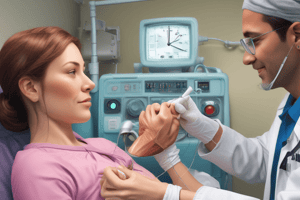Podcast
Questions and Answers
What is the main reason anesthetists focus on prevention in managing aspiration of gastric contents?
What is the main reason anesthetists focus on prevention in managing aspiration of gastric contents?
- Aspiration can lead to serious complications during anesthesia. (correct)
- Aspiration is inevitable in high-risk patients.
- Aspiration typically occurs only under general anesthesia.
- Aspiration is commonly treated with antibiotics.
Which of the following is a recommended preoperative measure to prevent aspiration?
Which of the following is a recommended preoperative measure to prevent aspiration?
- Using a rapid sequence induction. (correct)
- Performing a routine intubation.
- Administering only IV fluids preoperatively.
- Encouraging the patient to eat before surgery.
What should be done first if a patient aspirates during anesthesia?
What should be done first if a patient aspirates during anesthesia?
- Prepare for intubation without further actions.
- Place the OR bed in the Trendelenburg position. (correct)
- Administer drugs for sedation.
- Perform an emergency bronchoscopy immediately.
What is one of the vital actions that must be taken immediately after aspiration?
What is one of the vital actions that must be taken immediately after aspiration?
What kind of ventilation should be provided between suctioning procedures after aspiration?
What kind of ventilation should be provided between suctioning procedures after aspiration?
Why is it important to have a fully functional suction device available during anesthesia?
Why is it important to have a fully functional suction device available during anesthesia?
In the management of aspiration, which drug type may be administered to maintain blood pressure and airway dilation?
In the management of aspiration, which drug type may be administered to maintain blood pressure and airway dilation?
What might an anesthesiologist give to reduce inflammation after aspiration occurs?
What might an anesthesiologist give to reduce inflammation after aspiration occurs?
What immediate action should be taken if a bronchospasm occurs during anesthesia?
What immediate action should be taken if a bronchospasm occurs during anesthesia?
What medications might an anesthetist choose to administer for bronchial dilation?
What medications might an anesthetist choose to administer for bronchial dilation?
Which procedure may be performed as a last resort for unmanageable laryngospasm?
Which procedure may be performed as a last resort for unmanageable laryngospasm?
What is the primary concern of aspiration during anesthesia?
What is the primary concern of aspiration during anesthesia?
Which group of patients is considered at the highest risk for aspiration during anesthesia?
Which group of patients is considered at the highest risk for aspiration during anesthesia?
Which condition could potentially increase the risk of aspiration due to gastrointestinal issues?
Which condition could potentially increase the risk of aspiration due to gastrointestinal issues?
During anesthesia administration, what can prolonged use of nitrous oxide cause?
During anesthesia administration, what can prolonged use of nitrous oxide cause?
What is a critical risk associated with the aspiration of solid particles?
What is a critical risk associated with the aspiration of solid particles?
What immediate concern is presented by gastric contents during aspiration?
What immediate concern is presented by gastric contents during aspiration?
What measures should be taken when a patient is suspected to have a full stomach?
What measures should be taken when a patient is suspected to have a full stomach?
What characterizes a total laryngospasm?
What characterizes a total laryngospasm?
Which condition is most likely to trigger bronchospasm during anesthesia?
Which condition is most likely to trigger bronchospasm during anesthesia?
What might increase the likelihood of spasm during anesthesia procedures?
What might increase the likelihood of spasm during anesthesia procedures?
Which drug class is particularly noted for promoting respiratory spasms?
Which drug class is particularly noted for promoting respiratory spasms?
Which of the following is NOT a cause of laryngospasm or bronchospasm?
Which of the following is NOT a cause of laryngospasm or bronchospasm?
What is a common characteristic of a partial spasm?
What is a common characteristic of a partial spasm?
Which of the following individuals is more vulnerable to spasm during anesthesia?
Which of the following individuals is more vulnerable to spasm during anesthesia?
Which response option describes how partial spasm can escalate if not treated?
Which response option describes how partial spasm can escalate if not treated?
Study Notes
Laryngospasm and Bronchospasm
- Laryngospasm involves involuntary contraction of the vocal cords; bronchospasm affects the bronchial muscle layer.
- Both can lead to airway obstruction, either partially or totally.
- Partial spasm may present with wheezing, gasping, and increased mechanical ventilation resistance; if untreated, it can progress to total spasm.
- Total laryngospasm causes complete glottis closure, leading to inability to breathe spontaneously.
Causes of Laryngospasm and Bronchospasm
- Commonly arises during induction or emergence from general anesthesia, particularly around intubation or extubation.
- Bronchospasm is likely during the induction phase of general anesthesia.
- Cigarette smoking and chronic bronchitis increase susceptibility to spasms.
- Contributing factors include:
- Drug reactions, particularly those promoting histamine release or beta-blockers.
- Anaphylactic reactions to drugs or blood transfusions.
- Mechanical irritation from airways, secretions, or inappropriate airway devices.
- Light anesthesia and excessive head/neck movement can increase spasm likelihood.
- Surgical manipulation affecting the vagus nerve or abdominal structures.
- Positive-pressure ventilation and painful stimuli during anesthesia induction or emergence.
- Pre-existing conditions like emphysema, asthma, or reactive airway disorders.
Management of Laryngospasm and Bronchospasm
- Immediate cessation of routine procedures is essential; the circulator assists the anesthetist in diagnosis and treatment.
- Steps to manage include:
- Administer oxygen via manually squeezing the rebreathing bag; if difficult, the circulator assists.
- Deepen anesthesia with additional medications; muscle relaxants and bronchial dilators may be used based on the cause.
- Clear irritants using suction if irritation is suspected.
- Perform emergency intubation if not already intubated.
- If laryngospasm continues, consider a tracheotomy or cricothyroidotomy as a last resort.
Aspiration Concerns
- Aspiration of gastric contents poses severe risks, potentially leading to chemical pneumonitis and lung damage.
- Risks include complete airway obstruction and atelectasis due to aspirated solids blocking the bronchi.
- Common risk factors for aspiration involve:
- Presence of food in the stomach, particularly in trauma, emergency surgery, pregnant patients, and those with gastrointestinal issues.
- Preoperative anxiety or certain narcotics can cause pyloric valve spasms, retaining gastric contents.
- Administered anesthetic gas can increase stomach pressure and risk of aspiration.
Management of Aspiration
- Focus is primarily on prevention; high-risk patients may require:
- Awake intubation (rare), rapid sequence induction, or preoperative antiemetics.
- Possible regional anesthesia or delayed surgery until stomach emptying.
- Key actions upon aspiration:
- Place the patient in the Trendelenburg position, turning the head sideways to aid drainage.
- Siphon the oropharynx, trachea, and bronchial tree to remove aspirated material.
- Prepare for emergency bronchoscopy if solid aspiration obstructs the airway.
- Administer continuous positive-pressure ventilation (100% oxygen) to avoid hypoxia.
- Use intravenous medications to dilate bronchi and maintain blood pressure; steroids may be given to reduce inflammation.
Studying That Suits You
Use AI to generate personalized quizzes and flashcards to suit your learning preferences.
Description
This quiz covers the key concepts of laryngospasm and bronchospasm, including their definitions, symptoms, and potential complications. Understand how these conditions can lead to airway obstruction and the importance of timely treatment to prevent severe respiratory issues.




